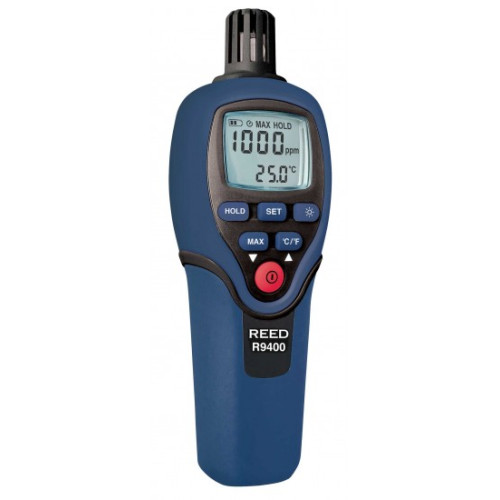REED R9400 Carbon Monoxide Meter with Temperature in Pakistan
- Brand: Reed Instruments USA
- Product Code: R9400
- Availability: Pre-Order
-
Rs.0
Dual LCD simultaneously displays carbon monoxide (CO) and ambient temperature.
Features
- Backlit LCD displays CO levels from 0 to 1000ppm and ambient temperature
- User-adjustable alarm limit (audible beep frequency increases as CO level rises)
- Quick response and high accuracy
- Data hold and max functions
- Self-test sequence on start-up
- Low battery indicator and auto shut off
REED R9400 Specifications
| Carbon Monoxide | |
| Measuring Range | 1 to 1000ppm |
| Accuracy | ±5% or ±5ppm |
| Resolution | 1ppm |
| Sensor Type | Stabilized electrochemical sensor |
| Temperature | |
| Measuring Range | -4 to 158°F (-20 to 70°C) |
| Accuracy | ±1.5°F (0.8°C) |
| Resolution | 0.1°F (0.1°C) |
| Sensor Type | Thermistor |
| General Specifications | |
| Display | 4-digit, dual LCD |
| Backlit Display | Yes |
| F/C Switchable | Yes |
| Alarm | Audible (buzzer) |
| Alarm Limit | User Adjustable |
| Max Hold | Yes |
| Display Hold | Yes |
| Warm-up Time | 60 seconds |
| Response Time | 2x per sec. |
| Auto Shut-off | Yes (after 30 mins, off) |
| Power Supply | 4 AA batteries |
| Battery Life | Approx. 200 hours |
| Low Battery Indicator | Yes |
| Product Certifications | CE |
| Operating Temperature | 32 to 122°F (0 to 50°C) |
| Storage Temperature | 14 to 140°F (-10 to 60°C) |
| Operating Humidity Range | 10-90% |
| Dimensions | 7.5 x 2.6 x 1.7" (190 x 65 x 45mm) |
| Weight | 8.3oz (235g) |
What's included with the REED R9400
- Carbon Monoxide Meter with Temperature
- Batteries
- Soft Carrying Case
Ideal Applications for the REED R9400
- Residential and commercial safety.
- Verifying furnaces, cookers, water boilers, and gas room heaters.
In the field with the REED R9400
We all know that Carbon Monoxide (CO) exposure needs to be taken seriously as it can have alarming effects on human health.
Let’s get started!
Inhaling high levels of CO causes oxygen starvation which can affect vital organs like the heart, brain, and nervous system. CO is extremely dangerous because we cannot detect the presence or level of the gas as it has no taste or smell and cannot be seen. People suffering from heart disease are even more vulnerable, as even short-term exposure to elevated CO levels may result in critical health issues.
Initial symptoms of CO poisoning may include flu-like symptoms such as headache, dizziness, weakness, nausea, and fatigue. In case of prolonged or high exposure, this may lead to vomiting, loss of consciousness, and collapse. Furthermore, it may lead to a coma or death if high exposures continue.
Let’s break down the effects of CO poisoning at the various parts-per-million (ppm) levels:
| PPM RANGE | EFFECTS |
|---|---|
| 0 to 1 ppm | Normal background levels |
| 9 ppm | ASHRAE Standard 62-1989 for living areas |
| 35 ppm | The average exposure level per U.S. OSHA workplace standards |
| 50 ppm | OSHA enclosed space 8-hour average level* |
| 100 ppm | OSHA exposure limit* |
| 200 ppm | Mild headache, fatigue, nausea, and dizziness |
| 400 ppm | Headache occurs in 2.5 to 3.5 hours |
| 800 ppm | Dizziness, nausea and convulsions, Death within 2 to 3 hours |
*U.S. Department of Labor, Occupational Safety & Health Administration (OSHA) Regulation 1917.24: The CO content in any enclosed space shall be maintained at not more than 50 ppm (0.005%). Remove employees from enclosed space if the CO concentration exceeds 100 ppm (0.01%).
Steps to ensuring a safe environment:
- Avoid keeping your vehicle idle for extended periods of time indoors.
- Avoid using fuel-burning appliances such as generators or engines in low ventilated areas.
- Ensure proper usage and preventive maintenance of heating components such as gas or water heaters or any other gas, oil, or coal-burning appliances, etc.
- If you're in the presence of high CO levels, get some fresh air, or ensure the environment is modified to allow for proper ventilation.
4 reasons why CO monitoring is important:
- Carbon Monoxide can be released by almost any combustion source such as vehicles, gas heaters, generators, furnaces in enclosed places and many such common sources present everywhere, adding to the carbon monoxide levels already present in the atmosphere.
- It cannot be smelled or tasted and cannot be seen, thus it remains undetectable by humans even at higher levels making it a “silent killer”.
- Carbon Monoxide poisoning is lethal as it hinders the ability of the blood to carry oxygen to vital organs such as the heart and brain.
- Carbon Monoxide monitoring is an efficient way to prevent CO poisoning as it helps detect the buildup of carbon monoxide levels and alerts when a certain level is exceeded.
Carbon Monoxide monitors have been the preferred solution for ambient air monitoring as they yield more accurate CO concentrations and are inexpensive compared to other solutions. Perform safety checks on gas-powered machinery, with a Carbon Monoxide monitor that sounds an alarm to let you know when exposure levels are too high.

